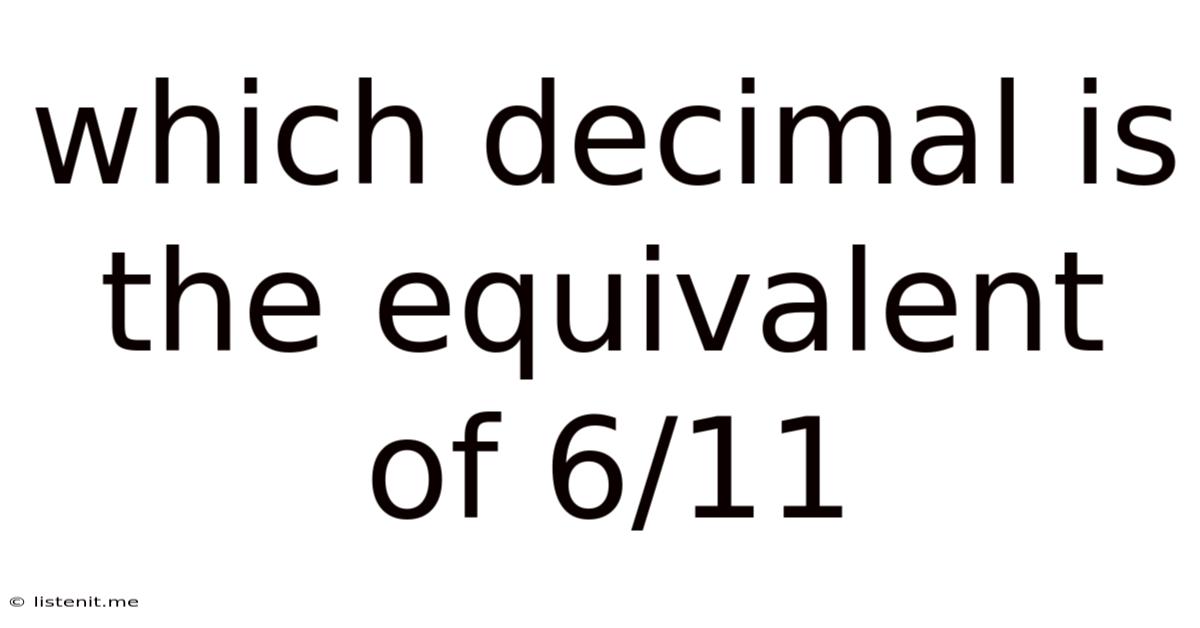Which Decimal Is The Equivalent Of 6/11
listenit
May 10, 2025 · 4 min read

Table of Contents
Which Decimal is the Equivalent of 6/11? A Deep Dive into Decimal Conversion
Finding the decimal equivalent of a fraction might seem straightforward, but understanding the process fully unlocks a world of mathematical understanding. This article delves deep into converting the fraction 6/11 into its decimal form, exploring different methods and highlighting the underlying mathematical principles. We'll also touch upon the significance of repeating decimals and their representation.
Understanding Fractions and Decimals
Before we embark on the conversion of 6/11, let's establish a firm understanding of fractions and decimals. A fraction represents a part of a whole, expressed as a ratio of two integers: the numerator (top number) and the denominator (bottom number). A decimal, on the other hand, represents a fraction where the denominator is a power of 10 (10, 100, 1000, etc.). The decimal point separates the whole number part from the fractional part.
For instance, the fraction 1/2 is equivalent to the decimal 0.5 because 1/2 can be expressed as 5/10. Similarly, 1/4 is equivalent to 0.25 (25/100). However, not all fractions convert neatly into terminating decimals. Some result in repeating decimals, as we'll see with 6/11.
Method 1: Long Division
The most fundamental method for converting a fraction to a decimal is through long division. We divide the numerator (6) by the denominator (11):
0.545454...
11 | 6.000000
-5.5
-----
0.50
-0.44
-----
0.060
-0.055
-----
0.0050
-0.0044
-----
0.00060
...and so on
As you can see, the division process continues indefinitely, with the digits "54" repeating. This is a repeating decimal, often denoted by placing a bar over the repeating digits: 0.5̅4̅. This means the sequence "54" repeats infinitely.
Understanding the Remainders
The key to understanding why 6/11 results in a repeating decimal lies in the remainders during the long division process. Notice how the remainders cycle through values (5, 6, 5, 6,...). When a remainder repeats, the corresponding quotient digits will also repeat.
Method 2: Converting to a Power of 10 (Not always possible)
Ideally, we would love to convert the denominator (11) into a power of 10. However, this isn't directly possible as 11 is not a factor of any power of 10 (10, 100, 1000, etc.). This is why we encounter a repeating decimal. This method highlights the limitations of directly converting some fractions to terminating decimals. For fractions with denominators that are factors of powers of 10 (like 2, 5, 4, 8, 25, etc.), this method works flawlessly.
Method 3: Using a Calculator
Modern calculators readily provide decimal equivalents for fractions. Simply enter 6 ÷ 11, and the calculator will display 0.545454... (or a similar representation depending on the calculator's display limitations). While convenient, understanding the underlying process (long division) remains crucial for true mathematical comprehension.
The Significance of Repeating Decimals
Repeating decimals, also known as recurring decimals, are rational numbers. This means they can be expressed as a fraction of two integers. The fact that 6/11 yields a repeating decimal doesn't diminish its rational nature; it simply demonstrates that not all rational numbers have a neat, terminating decimal representation.
Representing Repeating Decimals
Mathematicians use various notations to represent repeating decimals concisely. Besides the overbar notation (0.5̅4̅), other methods include:
- Using ellipses: 0.545454... This indicates the pattern continues indefinitely.
- Using brackets: 0.(54) – This clearly shows the repeating block.
The choice of notation depends on the context and personal preference, but the key is clarity and unambiguous representation of the infinite repeating pattern.
Practical Applications of Decimal Conversions
Converting fractions to decimals has widespread applications across various fields:
- Engineering and Physics: Precise calculations often require converting fractions to decimals for easier manipulation and analysis.
- Finance and Accounting: Calculating percentages, interest rates, and proportions frequently involves converting fractions to decimals.
- Computer Science: Representing numbers in computer systems often involves converting between fractions and decimals, especially in binary and hexadecimal systems.
- Everyday Life: Dividing items equally, measuring ingredients in recipes, and understanding discounts all benefit from a strong grasp of fraction-to-decimal conversion.
Advanced Considerations: Continued Fractions
For those interested in exploring deeper mathematical concepts, converting fractions to continued fractions provides an alternative representation. A continued fraction expresses a number as a sum of integers and fractions of integers. This representation, while more complex, offers unique insights into the mathematical properties of numbers. However, this is beyond the scope of this introductory article.
Conclusion
The decimal equivalent of 6/11 is 0.5̅4̅, a repeating decimal. Understanding this conversion, along with the methods used to arrive at the result, is fundamental to appreciating the interplay between fractions and decimals. While calculators offer a convenient shortcut, comprehending the long division process and the significance of repeating decimals enhances mathematical fluency and problem-solving capabilities across numerous disciplines. The ability to effortlessly convert fractions to decimals and understand the properties of repeating decimals empowers you to tackle more complex mathematical challenges with confidence. Remember to practice these methods regularly to enhance your understanding and speed.
Latest Posts
Latest Posts
-
What Is The Hybridization Of The Central Atom In Sf4
May 10, 2025
-
How Else Can The Ratio 14 1 Be Written
May 10, 2025
-
Square Root Of 130 Simplified Radical Form
May 10, 2025
-
Why Do Scientists Use Standardized Units
May 10, 2025
-
Name Seven Characteristics That Can Be Used To Describe Minerals
May 10, 2025
Related Post
Thank you for visiting our website which covers about Which Decimal Is The Equivalent Of 6/11 . We hope the information provided has been useful to you. Feel free to contact us if you have any questions or need further assistance. See you next time and don't miss to bookmark.